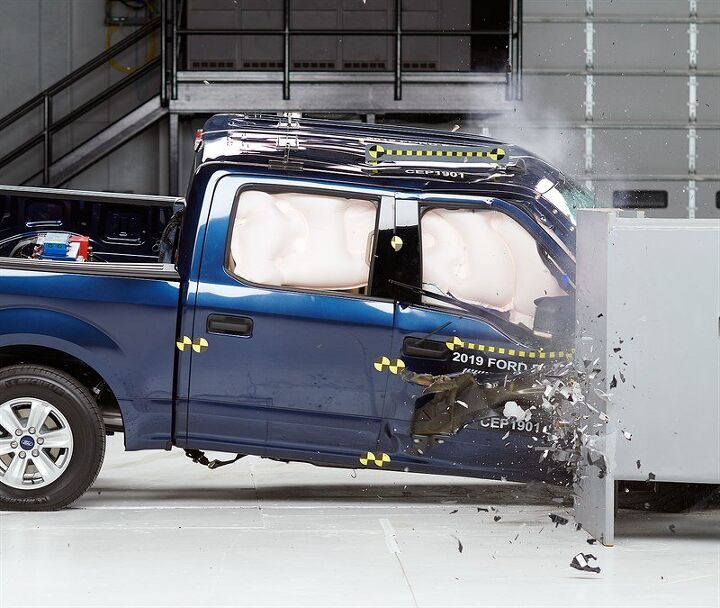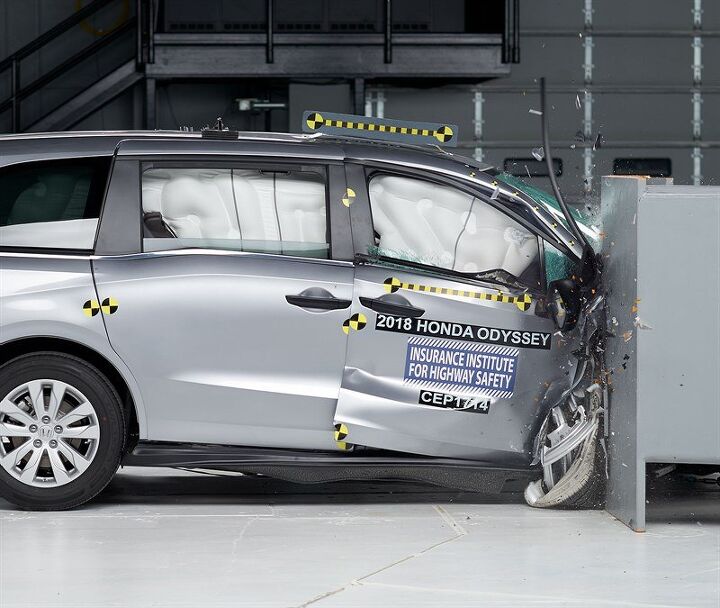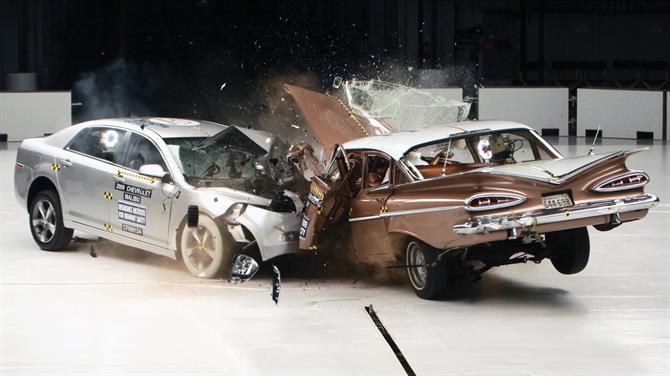#IIHS
Jeep Wrangler Once Again Earns Dismal Crash-test Rating Using Euro-based Metrics
Despite the previous generation boasting above-average frontal crash test scores from the United States’ Insurance Institute for Highway Safety (IIHS), Jeep’s new Wrangler has earned harsh criticism in Europe and Australia. The model received a one-star European New Car Assessment Programme (NCAP) crash rating in December, followed by a similar review from the Australasian New Car Assessment Program (ANCAP) this month.
That makes it the only one-star vehicle in that particular market, which is not a position Fiat Chrysler wants to find itself in. However, as FCA took great strides in improving the Wrangler for on-road duty — including adding dual front and side airbags as standard — the dismally low score is a bit of a mystery.
IIHS to Automakers: Stop Tapping the Brakes on Rear-seat Safety
The Insurance Institute for Highway Safety, currently on a never-ending quest to improve automotive safety and provide underwriters with data, suggested on Thursday that rear-seat passengers are getting the short end of the stick. The announcement comes shortly after the State of Washington announced a new law that would update its Child Passenger Restraint Law, requiring older children to utilize a booster seat.
Having looked at rear-seat safety for years, the IIHS claims rear-seat occupants are now at a disadvantage compared to occupants in the front row. The group aims to develop a new evaluation method to encourage automakers to improve safety systems for back seat passengers and track their progress.
Crash Test Dummies: Ford Tops IIHS Tests, Everyone's Headlights Suck
There are wars being waged on all fronts in the half-ton pickup truck market, from towing prowess to outright power ratings. Not ones to pass up an opportunity to bash their competitors over the head with a truck-shaped chair, manufacturers seem to take every opportunity to harangue their opponents – especially when empirical data puts them in the driver’s seat.
The latest to do so? Ford, leveraging the recent IIHS crash test results of its 2019 F-150 Crew Cab pickup to take a shot or three at The General.
Tap the Brake: IIHS Adds Wayward Pedestrians to Its Testing Regimen
Not satisfied with turning up the heat on automakers via new crash tests and headlight performance evaluations, the Insurance Institute for Highway Safety now has pedestrian avoidance systems under its microscope.
In its first round of tests, IIHS looked at the systems offered in 11 popular subcompact through midsize crossovers — vehicles that aren’t hard to imagine roaming leafy streets where wayward soccer balls (and those who chase them) lurk behind every parked car. The good news for both drivers and manufacturers? Nine of the 11 scored good marks.
Too bad about Mitsubishi and BMW…
The 57 Models That Received IIHS Safety Awards for 2019 (Spoiler: There Aren't Many Americans)
Despite perpetually raising the bar on what constitutes automotive safety, the Insurance Institute for Highway Safety just gilded nearly five dozen models with Top Safety Pick or Top Safety Pick Plus awards. The metrics, which now hinge largely on a vehicle possessing crash avoidance systems and superior headlamps, require the highest rating available in passenger-side protection during its small overlap front crash to get the coveted Plus decoration — which 30 vehicles qualified for in the initial 2019 model year evaluation.
Hyundai, which managed to walk away with the most awards, swiftly issued a press release to humblebrag that it bested the competition two years running. Considering how well the Koreans performed, it was likely warranted. Automakers absolutely love this kind of stuff, so you can expect to see future references made to the awards in the next batch of car commercials.
Headlights Still Largely Suck, Just Not As Much As Last Year
A collective groan must have echoed through the automotive industry a couple of years back, after the Insurance Institute for Highway Safety began testing headlight performance. Early results showed that most headlights, even those on expensive vehicles, fell well short of optimal performance. Most fell short of acceptable performance.
Since then, improvements have begun — slowly, but surely. It’s in an automaker’s best interest to slap a couple of bright peepers on the front of their vehicles from a PR and marketing perspective, but there’s cost issues to be considered. Still, no vehicle can take home that coveted Top Safety Pick+ rating without good headlights.
In its 2018 testing, some 32 models offered standard or available headlights worthy of a “good” rating. That’s out of 165 models.
Insurers Rejoice! Headlamp Replacement Costs Are Still Really High, Says IIHS
Unless you’re still tooling around in a hand-me-down rig donated by your grandfather, chances are good you’re not in possession of a car outfitted with sealed-beam headlamps. That car might also have real 5 mpg bumpers, further insulating you from lofty repair costs.
For owners of newer cars, plenty of pain awaits after a fender-bender, though advances in passive restraints have relegated most of that pain to your wallet. After smashing through potentially thousands of dollars of camera and sensor gear housed in your bumper and grille, the next thing damaged in a low-speed, front-end impact is your headlamps. New figures from the Insurance Institute for Highway Safety reveal what you’re likely to pay for a replacement. (Hint: it’s a lot.)
However, if you’re one of the few people who shelled out for a new Lincoln Continental this year, there’s good news here.
2019 Ram 1500 Aces Crash Tests, Stymied by Headlights
You win some, you lose some. For Fiat Chrysler, the new Ram 1500 represents more of a win, both in terms of quality, drive experience, and especially crash ratings, which just rolled in from the Insurance Institute for Highway Safety.
The previous-generation 1500 lost marks in two areas: driver-side small-overlap front impacts (a weakness it shares with FCA’s rear-drive passenger cars) and roof strength. Both of these tests earned the 2018 1500 a “marginal” rating from the IIHS, sinking its overall score. FCA engineers clearly did their homework — the new truck aced all crash tests. Too bad about those peepers, though.
IIHS Recommends Putting Your Teen Behind the Wheel of the Largest Vehicle Possible
Assuming you’re the sort of parent who’s willing and able to buy your child their first vehicle, you’ve probably made safety your top priority. While you could purchase a new vehicle with all the latest self-preservation tech, teens have a habit of scratching up cars. If you buy them an old clunker, they’ll learn a valuable lesson about the importance of auto maintenance but won’t be as protected when they crash into something — which they’re statistically more likely to do.
The Insurance Institute for Highway Safety recently updated its list of recommended vehicles for teens, promoting the “bigger is better” mentality. It claims an older, larger used vehicle is often a safer choice when compared to a newer small vehicle that costs roughly the same. While the institute’s suggestion makes sense, it’s also one step removed from recommending putting teenagers in armored personnel carriers.
Automakers Ready to Rock When New NHTSA Headlight Rules Arrive
The National Highway Traffic Safety Administration announced earlier this month that it was willing to considering changing the rules that govern automobile headlights. Now in a comment period before its official review, the proposal would permit automakers to install and enable adaptive driving beam headlights on new cars sold in the United States. While some automakers are preparing themselves for the change, most have been ready for ages.
One one hand, this proposed change should help lousy drivers from burning out your retinas on a lonesome country road. But, by the same token, you may no longer have the delicious opportunity to blast them with the brights once they’re within a few feet of your car to let them know to lower those damned high beams.
Just kidding, that would be illegal. Federal mandates require all drivers to dim their headlights when approaching within 500 feet of an oncoming vehicle or when approaching a vehicle less than 300 feet ahead. Of course, nobody we know has ever witnessed this law being actively enforced — even though it’s probably as dangerous as moderate speeding infractions. Regardless, it’ll gradually become a non-issue if the rules change.
Higher Risk: Study Claims States That Legalized Marijuana Have More Traffic Accidents
The Insurance Institute for Highway Safety and the Highway Loss Data Institute announced Thursday that auto crashes in states with legalized recreational marijuana have increased 6 percent. Both groups will be on hand at the Combating Alcohol-and Drug-Impaired Driving summit at IIHS’ Vehicle Research Center in Ruckersville, Virginia to present two studies on the issue. Perfect timing, considering Canada just became the second country to legalize the substance and support for decriminalization continues to grow in the United States.
Of course, things are rarely so simple. While the IIHS and HLDI remain confident in their research, the National Highway Traffic Safety Administration claimed marijuana use was unlikely to contribute to traffic mishaps in any meaningful way back in 2015. And that’s just for starters. There is so much conflicting information on this issue, it’ll make your head spin harder than the most savage bong rip of your life, bro.
Honda Odyssey Reigns Supreme in Latest Minivan Crash Test
You don’t need a family to own a minivan, it just helps avoid a series of awkward follow-up questions. However, regardless of whether you’re riding with your complete progeny or your only friend in the world, you probably hope your vehicle has your back in the event of an accident.
The Insurance Institute for Highway Safety’s small overlap crash test separated the wheat from the automotive chaff ever since its introduction in 2012. The test imagines what happens when the front corner of a vehicle collides with another vehicle or an stationary object, focusing an immense amount of energy on a small area of the automobile. It’s a worst-case scenario for the structural integrity of a model and makes for a great viewing experience, as it really does a number on the test car.
Despite fielding a rather pathetic number of vehicles, the minivan segment performed pretty well in the IIHS passenger-side small overlap front crash test on the whole. However, while no outright deathtraps revealed themselves, the group still saw some mixed results.
Two Aging Midsize SUVs Fail Latest Round of Crash Tests
The Insurance Institute for Highway Safety never rests, always thinking up new ways to expose flaws in contemporary passenger vehicles. Lately, the IIHS has begun applying the dreaded small overlap front crash test to the passenger side of new models. There’s a seat on that side for a reason, and it’s not inconceivable that a roadside utility pole or obstruction could take out that corner of the vehicle.
The latest IIHS test put popular midsize crossovers through their paces, exposing serious safety concerns in two models.
NHTSA Study Confirms New Cars Are Safer, Regulations Not a Scam
You might want to sit down for this one. The National Highway Traffic Safety Administration (NHTSA) released a study this week showing older cars without modern day safety hardware are — and I’m sorry to say this — far more dangerous than newer vehicles. Unbelievable, right?
Of course not. As tacked on and obnoxious as a lot of safety regulations often seem, they are delivering onto us safer automobiles. The old maxim of “they don’t build cars like they used to” is absolutely true, but not in the way your grandfather meant it. According to data compiled from the U.S. government’s Fatality Analysis Reporting System (FARS) between 2012 and 2016, fatal incidents occurred in older model-year vehicles at a much higher rate than their newer counterparts. Not surprisingly, the NHSTA also suggested the severity of an occupant’s injuries increase the older a vehicle gets.
Still, the disparity between the vehicle age groups is surprisingly vast.
Deadly Design: SUV Proliferation a Contributing Factor in Pedestrian Deaths, Study Says
Sport-utility vehicles and crossovers are great for families who want maximized interior volume and a sense of security, but the high-riding vehicles are a double-edged sword. In addition to being less economical than a sedan with a similar footprint, the design doesn’t bode well for pedestrians. In fact, the proliferation of SUVs may be the largest contributing factor to pedestrian fatalities right now. From 2009 to 2016, fatal single-vehicle crashes involving utility vehicles increased by 81 percent.
That’s disconcerting, considering the number of pedestrian killed on U.S. roads declined by 20 percent since 1975, hitting an all-time low in 2009. However, in 2016 the death toll had climbed back up to the highest levels since 1990. The Governors Highway Safety Association estimated nearly 6,000 people were fatally struck by vehicles last year, with around 4,700 of those deaths occurring in urban or suburban areas. Conversely, those same environments only saw 2,959 deaths in 2009.
The increase in fatalities cannot be contributed entirely to the design of SUVs. Distracted driving, encouraged by smart phones and increasingly complicated infotainment systems, has undoubtedly pressed the issue. But, when a strike does occur, the shape of a vehicle still plays an enormous factor.






























Recent Comments